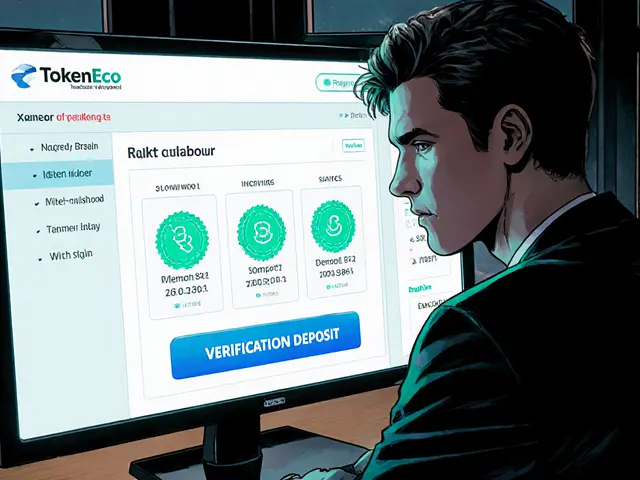Vietnam's New Crypto Licensing Framework: Directive 05/CT‑TTg Explained
Vietnam has just leapt from a murky regulatory gray zone into a fully‑structured crypto regime. The government’s Vietnam crypto licensing framework - known officially as Directive 05/CT‑TTg - reshapes how exchanges, investors, and developers can operate in the country. If you run a platform, trade crypto, or simply follow Southeast Asian policy, you need to know what the resolution demands, how it stacks up against neighboring rules, and what steps you must take to stay compliant.
Key Takeaways
- Resolution No. 05/2025/NQ‑CP creates a five‑year pilot licensing system for crypto exchanges, effective immediately with a six‑month grace period.
- Minimum charter capital is 10 trillion VND (≈ USD 379 million); at least 65 % must come from institutional investors, and foreign ownership is capped at 49 %.
- All transactions must settle in Vietnamese dong; fiat‑backed stablecoins are prohibited.
- Exchanges must integrate KYC/AML systems with the State Bank of Vietnam’s monitoring platform and follow the TCVN 13057:2025 cryptography standard.
- Only 3‑5 platforms are expected to qualify in the first year, serving roughly 5 million users out of an estimated 21 million.
What is Directive 05/CT‑TTg?
Resolution No. 05/2025/NQ‑CP is a government decree issued on 9 September 2025 that establishes Vietnam’s first formal licensing regime for cryptocurrency exchanges. Signed by Deputy Prime Minister Ho Duc Phoc, the resolution implements key clauses of the Law on Digital Technology Industry passed earlier that year. Its primary goal is to move the $1.2 billion crypto market out of the legal shadows and into a state‑supervised environment, while still encouraging innovation in blockchain‑based services.
Capital and Ownership Requirements
The capital threshold is the most eye‑catching provision. Exchanges must have a charter capital of at least 10 trillion VND - roughly USD 379 million at September 2025 rates. Article 4, Clause 2 mandates that 65 % of this amount (6.5 trillion VND) come from institutional investors such as banks, venture funds, or state‑owned enterprises.
Foreign ownership is limited to 49 % of the equity structure, meaning Vietnamese shareholders keep majority control. This rule, clarified by Dirox’s legal analysis on 15 September 2025, aims to prevent foreign‑dominant platforms while still allowing strategic partnerships.
For comparison, see the table below:
| Country | Minimum Capital | Foreign Ownership Cap |
|---|---|---|
| Vietnam | 10 trillion VND (~USD 379 M) | 49 % |
| Thailand | 500 million THB (~USD 13.7 M) | 100 % |
| Singapore | Variable (depends on scope) | No explicit cap |
| Japan | JPY 5 billion (~USD 45 M) for Type 1 licences | No cap, but majority‑Japanese board required |
| China | Ban on exchanges | N/A |
The Vietnamese requirement is roughly 27 times higher than Thailand’s and far above Singapore’s tiered approach, signalling a deliberate strategy to limit participants to well‑capitalized entities.

Operational Rules: Currency, Assets, and Technology
All crypto‑related transactions must be settled exclusively in Vietnamese dong (VND). Direct foreign‑currency settlements are forbidden under Article 7, aligning Vietnam with Indonesia’s rupiah‑only rule and contrasting with Malaysia’s more permissive model.
Article 5, Clause 3 bans the issuance of assets backed by fiat currencies or securities. This effectively eliminates stablecoins that are pegged to the US dollar or euro - a notable limitation given that stablecoins account for more than 70 % of global stablecoin volume (Messari, Aug 2025).
Exchanges must also adopt the National Cryptography Standard TCVN 13057:2025, issued by the Ministry of Information and Communications in August 2025. Compliance ensures that blockchain implementations meet government‑approved encryption and data‑integrity protocols.
On the AML front, platforms are required to integrate their KYC processes with the State Bank of Vietnam’s real‑time transaction monitoring system. The Ministry of Finance’s Crypto Asset Regulatory Department (CARD) will audit these integrations during the licensing review.
Impact on Existing Exchanges - Costs and Timeline
For the thousands of unlicensed exchanges operating today, the transition is steep. Legal firm Duane Morris Vietnam estimates compliance costs ranging from 50 billion to 200 billion VND (USD 1.9 - 7.6 million) per entity. Smaller players, like the Reddit user “HanoiTrader88” who runs a platform with 5 billion VND capital, face a capital shortfall of over 80 %.
The six‑month grace period starts after the first license is issued, but the first licences are not expected until 90‑120 days after the application window opens (Deputy Minister Tran Hoang An, 15 Sept 2025). This leaves a narrow window for fundraising, system upgrades, and staff training.
According to a CoinGeek survey of 1,500 Vietnamese crypto users, 41 % said they would consider moving to offshore platforms if domestic options become too restrictive. Yet 68 % also expressed support for regulatory oversight, highlighting a split between security‑focused users and those who value low‑cost, high‑speed services.
Regional Context - How Vietnam Stacks Up
Vietnam’s model lands between Singapore’s liberal approach and China’s outright ban. While Singapore allows a mix of domestic and foreign entities with capital requirements that vary by service line, Vietnam enforces a single, hefty capital floor. Thailand’s lower threshold has already attracted a dozen licensed exchanges, but its regulatory framework is viewed as less rigorous on AML monitoring.
Japan’s licensing system is more flexible regarding foreign ownership, yet its capital requirements are far lower than Vietnam’s. The Vietnamese cap of 49 % foreign equity is stricter than Japan’s but looser than China’s total prohibition.
These contrasts matter for investors: a venture capital firm looking to back a regional crypto hub will weigh Vietnam’s controlled market, Singapore’s open ecosystem, and Thailand’s moderate regime before allocating funds.
Future Outlook - Pilot Period, Taxes, and Market Potential
The resolution outlines a five‑year pilot (2025‑2030) with mandatory reviews at 12, 24, and 36 months. Adjustments to capital thresholds could be made if market stability indicators show undue strain.
Tax regulations are slated for finalization by 15 November 2025. Deputy Minister Tran Hoang An announced a capital‑gains tax of 0.1 % for transactions under 100 million VND and 0.3 % for larger trades. While modest, the tax introduces a new revenue stream for the state and adds a compliance layer for traders.
World Bank projections suggest that a regulated crypto market could contribute 1.2‑1.8 % of Vietnam’s GDP by 2030, supporting the broader goal of raising the digital economy’s share from 9.5 % (2024) to 20 % of GDP by 2030. Fitch Solutions forecasts annual transaction volumes of $15‑20 billion by 2028 if the pilot succeeds, positioning Vietnam as the third‑largest regulated crypto market in Southeast Asia behind Singapore and Thailand.
Practical Checklist for Exchange Operators
- Confirm eligibility: at least three years of financial‑services experience and compliance with the Ministry of Finance’s Draft Circular 35.
- Secure institutional capital to meet the 10 trillion VND floor; ensure 65 % originates from Vietnamese‑based investors.
- Structure ownership so foreign shareholders hold no more than 49 % of equity.
- Upgrade technology stack to comply with TCVN 13057:2025 encryption standards.
- Integrate KYC/AML workflows with the State Bank of Vietnam’s monitoring API.
- Replace any fiat‑backed stablecoin offerings with asset‑backed tokens that meet the “real underlying asset” rule.
- Prepare VND‑only settlement pipelines, leveraging the NDAChain national blockchain for real‑time clearing.
- Submit the full licensing dossier within 15 banking days of the application opening; track the six‑month grace period closely.
Following these steps will dramatically improve your chances of receiving one of the limited licences and avoid costly shutdowns.
Frequently Asked Questions
What is the timeline for the first exchange licences?
The Ministry of Finance expects the application portal to open within 30 days of the resolution’s publication. First licences should be granted 90‑120 days after the portal opens, giving a total window of roughly four to five months from the announcement.
Can a foreign‑owned exchange operate in Vietnam?
Yes, but foreign shareholders cannot exceed 49 % of the total equity. The majority stake must be held by Vietnamese individuals or entities, and the board must reflect Vietnamese control.
Are stablecoins completely banned?
Stablecoins that are backed directly by fiat currencies or securities are prohibited. Token projects must be linked to real underlying assets such as commodities or government‑issued bonds to comply.
How will taxes on crypto trades be applied?
Capital‑gains tax rates are set at 0.1 % for trades under 100 million VND and 0.3 % for larger transactions. Taxes are to be reported in the annual personal income tax filing.
What technology standards must licensed exchanges follow?
Exchanges must conform to the National Cryptography Standard TCVN 13057:2025, use the NDAChain national blockchain for VND settlements, and integrate with the State Bank of Vietnam’s transaction‑monitoring API for AML compliance.








Directive 05/CT‑TTg is a major shift for Vietnam’s crypto ecosystem, and there are several practical takeaways for anyone looking to set up an exchange there. First, the capital requirement of 10 trillion VND is non‑negotiable and must be sourced mainly from Vietnamese institutional investors, which means you’ll need to build strong local partnerships early. Second, the foreign ownership cap of 49 % ensures domestic control, so any foreign venture should plan to cede a controlling stake to a Vietnamese entity.
Third, all trading must settle in VND, effectively banning fiat‑backed stablecoins and requiring you to redesign any existing cross‑currency settlement flows.
Fourth, the mandatory integration with the State Bank’s AML monitoring API will likely involve significant IT work to meet real‑time reporting standards.
Fifth, compliance with the TCVN 13057:2025 cryptography standard means you cannot simply port over existing codebases without a thorough security audit.
Sixth, the six‑month grace period only starts after the first license is issued, and the licensing window itself may not open for another month, so time is of the essence.
Seventh, budgeting for compliance costs is crucial; legal firms estimate anywhere from 50 to 200 billion VND just for the licensing process.
Eighth, consider the human resources angle – you’ll need seasoned compliance officers familiar with Vietnamese banking regulations.
Ninth, for funding, targeting Vietnamese sovereign wealth funds or state‑linked banks can satisfy the 65 % institutional capital rule.
Tenth, keep an eye on the pilot review milestones at 12, 24, and 36 months, as they could adjust capital thresholds if the market shows strain.
Eleventh, the upcoming capital‑gains tax of 0.1 %/0.3 % is modest but will require integration with your tax reporting pipeline.
Twelfth, the potential market size – up to 5 million users in the first year – offers a sizable user base for early movers.
Thirteenth, the regional comparison shows Vietnam’s regime is stricter than Thailand’s but more open than China’s outright ban, positioning it as a middle ground for regional investors.
Fourteenth, aligning your board composition with Vietnamese control requirements will smooth the licensing review.
Finally, maintaining transparent communication with regulators throughout the pilot will improve your chances of securing one of the limited licences. By tackling each of these steps methodically, you’ll greatly improve your odds of success under Directive 05/CT‑TTg.
The new rules are basically a protectionist move to keep the foreign crowd out of Vietnam’s budding crypto scene. By capping foreign equity at 49 % and demanding massive local capital, the government is sending a clear message that this market belongs to Vietnamese hands. It’s understandable to want sovereign control, but the high capital bar might also scare away potential investment that could help the sector grow faster.
Reading through the directive, I’m struck by the balance Vietnam tries to strike between regulation and innovation. On one hand, the heavy capital requirement ensures only serious players enter, which could boost consumer confidence. On the other, the prohibition on stablecoins feels restrictive, especially given their utility for cross‑border payments. It will be interesting to see how the market adapts and whether alternative asset‑backed tokens fill that gap. The phased pilot reviews also suggest the authorities are open to tweaking the framework, which is a positive sign for long‑term development.
Vietnam’s bold step is a cultural milestone 🚀. Embracing a regulated crypto environment while preserving national monetary sovereignty shows a mature approach. The mandatory VND‑only settlement will certainly foster local liquidity, and the use of the NDAChain national blockchain adds a uniquely Vietnamese flavor to the ecosystem. Though the capital threshold is steep, it may attract high‑caliber institutional partners, paving the way for a robust, home‑grown industry. Let’s hope the pilot period brings innovative solutions that respect both global standards and local values! 🌏
Wow, a 10 trillion VND capital requirement – nice safety net for the regulators 🙄. At least the rule is crystal clear: bring a lot of money or stay home. And banning stablecoins? That’ll definitely keep the market ‘stable’, right? Good luck to anyone trying to launch a new platform under these conditions.
It’s fascinating how the directive forces exchanges to adopt the TCVN 13057:2025 cryptography standard. This could push the local tech talent to sharpen their skills in advanced encryption, which is a win for the broader cybersecurity landscape. Also, integrating with the State Bank’s AML API might set a precedent for other financial sectors in Vietnam.
For teams preparing their licensing dossiers, it’s essential to align your corporate governance with the Vietnamese majority‑ownership requirement. Establish clear reporting lines, ensure your board reflects local control, and document all institutional capital sources. This structured approach will not only satisfy regulators but also build investor confidence.
Sounds like a big hurdle.
Great overview! The capital requirement is definitely a barrier, but it also signals that only well‑funded players will survive, which can protect users from shady operators. I’m especially excited about the potential for VND‑only settlements to boost liquidity in the domestic market. Keep pushing forward, and let’s see how the pilot shapes the regional landscape!